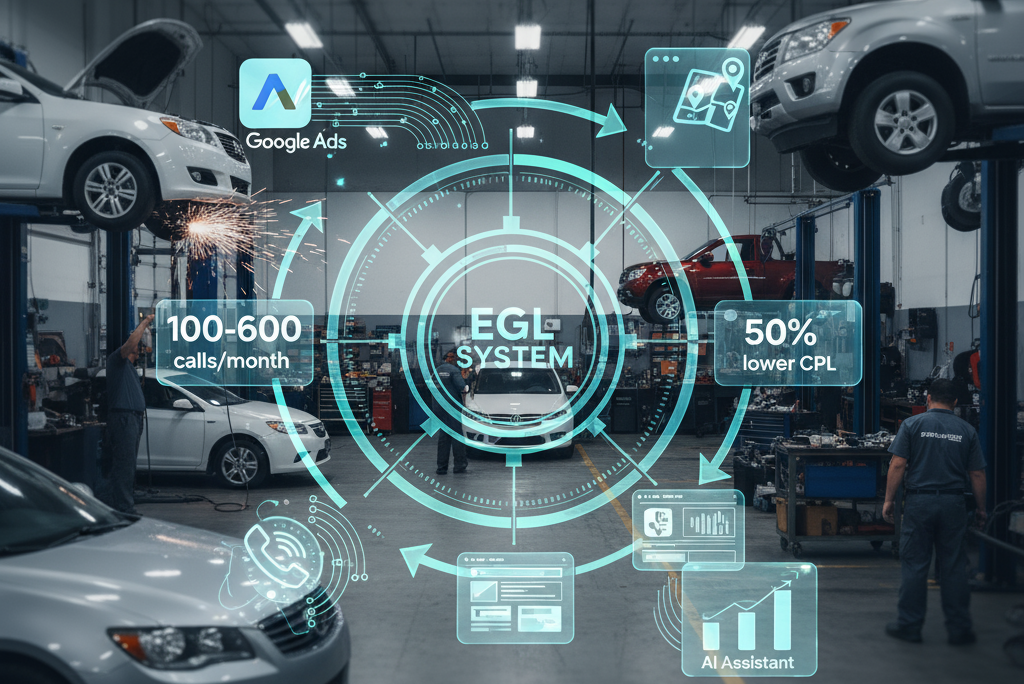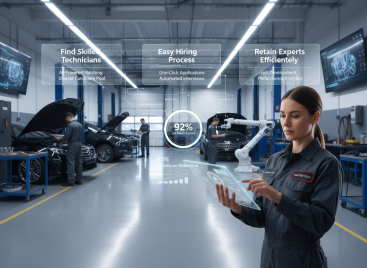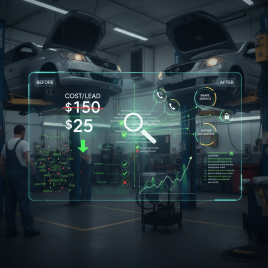Most auto shops struggle with inconsistent lead flow. Some months the phone rings constantly. Other months it’s crickets.
When we work with clients, our goal is simple: predictable, consistent, qualified call volume every single month. The shops we partner with typically receive 100-600 qualified calls monthly. Not tire-kickers asking about prices. Not spam calls. Real customers with vehicles that need repair, ready to book appointments.
Here’s the system we built to make that happen.
Contents:
- Introducing the EGL System (Element Growth Loop)
- Component 1: Traffic Generation
- Component 2: Conversion Points
- Component 3: Organic Growth Engine
- Component 4: Call Tracking and Analytics
- Component 5: AI Sales Assistant and Call Analysis
- Component 6: The Feedback Loop (Where the Magic Happens)
- How the Complete System Works in Practice
- The Results We Achieve
- Can You Build This Yourself?
- Why Integration Matters More Than Individual Tactics
Introducing the EGL System (Element Growth Loop)
The EGL System is an integrated, AI-driven marketing engine we designed specifically for auto and truck repair shops. It’s not a single tactic or tool—it’s a complete ecosystem where every component feeds into and improves the others. That’s what makes it powerful.
The system includes:
– Multiple traffic generation sources
– Conversion-optimized website infrastructure
– Comprehensive call tracking and analytics
– AI-powered call analysis and scoring
– Automated optimization feedback loops
Let me walk you through how each piece works and how they connect.
Component 1: Traffic Generation
Everything starts with getting qualified prospects to notice your shop. We use two primary channels:
Google Ads: We run service-specific campaigns (as detailed in our Google Ads article) targeting high-intent keywords. Someone searching “check engine light repair near me” is advertising-ready traffic.
Google Business Profile Optimization: We optimize your GBP for top 3 local map rankings (detailed in our local SEO article), generating consistent organic calls without ongoing ad spend.
These two sources work synergistically. Paid ads deliver immediate volume while we work on organic rankings. As organic improves, we can reduce ad spend or redirect budget to scale even further.
The key is balance: enough paid traffic to generate immediate results, while building organic assets that compound over time.
Component 2: Conversion Points
Once we’re driving traffic, we need to convert it efficiently. There are two primary conversion paths:
Website Landing Pages: Visitors from ads land on service-specific pages (created with our WP PageFlow AI system, detailed in our conversion optimization article). These pages are designed for one goal: getting the visitor to call.
Direct Calls from Ads: We also run call extensions and location extensions where prospects call directly from search results without visiting the website. This works exceptionally well for mobile traffic and urgent repair needs.
Both paths are optimized for conversion, but they serve different customer preferences. Some people want to research before calling. Others want immediate assistance.
By offering both, we capture a broader range of prospects.
Component 3: Organic Growth Engine
While paid ads generate immediate results, your Google Business Profile is a long-term asset that generates calls month after month without ongoing spend.
We manage and optimize GBPs continuously:
– Weekly posts with photos and updates
– Consistent review generation and response
– Photo uploads showcasing work
– Citation building and management
– Ongoing category and attribute optimization
For established shops with strong optimization, the GBP alone often generates 50-100+ calls per month. That’s essentially free traffic once the optimization is complete.
This organic component is what makes the system sustainable. You’re not forever dependent on ad spend to keep the phone ringing.
Component 4: Call Tracking and Analytics
Here’s where most shops lose visibility: they know ads are generating calls, but they don’t know which campaigns, which keywords, or which traffic sources are actually profitable.
We connect all traffic sources to a comprehensive call tracking system that assigns unique numbers to different channels:
– One number tracks Google Ads traffic
– Another tracks GBP calls
– Dynamic numbers track specific campaigns and keywords
This gives us complete visibility:
– Which keyword generated each call
– What time the call came in
– How long the conversation lasted
– Full call recording for quality review
This data is what enables optimization. We’re not guessing what works—we know.
For shops doing this themselves: call tracking isn’t optional if you want to scale efficiently. Services like CallRail start around $45/month and integrate with Google Ads and your website.
Component 5: AI Sales Assistant and Call Analysis
This is where the system gets intelligent.
Every call that comes in is processed by our AI Sales Assistant. This tool:
– Listens to the entire conversation
– Transcribes the call
– Analyzes call quality
– Scores the lead (qualified vs unqualified)
– Identifies whether an appointment was booked
– Flags issues (poor phone handling, missed opportunities)
This gives us data that call tracking alone can’t provide. We know not just that a call happened, but whether it was a good call, whether it converted, and what could have been better. When we review campaign performance, we’re not just looking at call volume—we’re looking at qualified call volume and conversion rates.
This is crucial because not all calls are equal. 100 calls with 20% qualified might be worse than 50 calls with 80% qualified. The AI helps us optimize for quality, not just quantity.
Component 6: The Feedback Loop (Where the Magic Happens)
Here’s what makes the EGL System truly powerful: the feedback loop.
Qualified calls identified by the AI Sales Assistant are automatically fed back into Google Ads as conversion data. This tells Google’s algorithm: “This keyword, this ad, this audience segment—that’s what we want more of.” Google’s machine learning then optimizes your campaigns automatically, showing your ads more frequently to people similar to those who became qualified leads.
This creates a compounding effect:
– Better targeting → more qualified calls → better data → smarter optimization → even better targeting
The system gets more efficient over time, not less. Cost per lead tends to decrease as the feedback loop accumulates data and Google’s algorithm learns.
This is why shops working with us for 6+ months often see better performance than in the first 90 days—the system is learning and improving continuously.
How the Complete System Works in Practice
Let me walk through a real example:
1. A truck owner in your city searches “diesel engine repair near me” at 10 AM on Tuesday.
2. Your Google Ad appears at the top of search results (because we’ve optimized for that keyword and Google’s algorithm has learned it converts well).
3. The prospect clicks the ad and lands on your diesel engine repair landing page (created with WP PageFlow AI, optimized for mobile, loads in 1.5 seconds).
4. They click the prominent “Call Now” button. The call tracking system assigns a unique number and routes the call to your shop while capturing all data.
5. Your service advisor answers, has a good conversation, and books an appointment.
6. The AI Sales Assistant processes the call, determines it was a qualified lead, and feeds that conversion data back to Google Ads.
7. Google’s algorithm notes: “Diesel engine repair keyword + this ad copy + this audience = qualified lead” and optimizes to show your ads to more similar prospects.
Meanwhile:
8. Your Google Business Profile (which we’ve optimized to rank #2 in the map pack) generates 3-4 additional calls that day from organic search.
9. Those calls also route through tracking, get analyzed by AI, and generate data for optimization.
10. At the end of the week, we review all performance data, identify what’s working best, and make manual optimizations on top of what Google’s algorithm is learning.
This is happening every single day, continuously improving and generating more qualified calls at lower costs.
The Results We Achieve
When the complete EGL System is implemented, shops typically see:
– 100-600 qualified calls per month (depending on market size and shop capacity)
– Cost per lead 40-50% lower than industry averages
– Consistent, predictable lead flow month over month
– Higher lead quality (more ready-to-book, fewer price shoppers)
– Complete visibility into marketing ROI
As you can see, the system isn’t ACTUALLY magic—it’s integration, automation, and continuous optimization working together.
Can You Build This Yourself?
The honest answer: parts of it, yes. The complete integrated system? That’s extremely difficult.
You can absolutely:
– Run Google Ads campaigns yourself
– Optimize your GBP following our local SEO article
– Implement call tracking
– Create landing pages
What’s hard to replicate:
– The AI Sales Assistant (custom-built tool)
– The automated feedback loop between call analysis and Google Ads optimization
– The integrated dashboard bringing all data together
– The continuous optimization across all components simultaneously
Most shops don’t have the time, tools, or expertise to build and manage this ecosystem while also running their business.
When we work with clients, they get the complete system without needing to understand how every piece works. They get the results—100+ qualified calls per month—while we handle the complexity behind the scenes.
Why Integration Matters More Than Individual Tactics
You could implement Google Ads without call tracking. You could optimize your GBP without landing pages. You could have landing pages without AI call analysis.
But each component works exponentially better when integrated with the others.
Call tracking without AI analysis tells you calls happened, not whether they were good calls. Google Ads without the feedback loop from qualified call data can’t optimize as effectively. Landing pages without call tracking can’t tell you which pages actually convert to booked jobs versus just phone calls. The power is in the integration. That’s what transforms individual tactics into a system that generates predictable, scalable results.
The shops dominating their markets don’t just do one thing well—they have complete systems where every element amplifies the others.
That’s what the EGL System delivers. And that’s how we consistently generate 100+ qualified calls per month for the shops we partner with.
Whether you build something similar yourself or work with experts to implement it, the principle remains: integrated systems beat isolated tactics every time.



